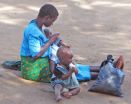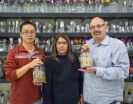(Press-News.org) A study of young twins in Malawi, in sub-Saharan Africa, finds that bacteria living in the intestine are an underlying cause of a form of severe acute childhood malnutrition.
The research, led by Washington University School of Medicine in St. Louis and reported Feb. 1 in the journal Science, shows how dysfunctional communities of gut microbes conspire with a poor diet to trigger malnutrition.
The discovery is bolstered by additional studies in mice, showing that gut microbes transplanted from malnourished children cause dramatic weight loss and alter metabolism when the animals are fed a nutrient-poor diet.
"The gut microbes of malnourished children and malnourished mice do not appear to mature along a normal, healthy trajectory," says senior author Jeffrey Gordon, MD, director of the Center for Genome Sciences & Systems Biology. "Feeding the children and the mice a high-calorie, nutrient-rich food had a temporary, beneficial effect on their gut microbes, but not enough to repair the dysfunction. Our results suggest we need to devise new strategies to repair gut microbial communities so these children can experience healthy growth and reach their full potential."
Childhood malnutrition is a common problem in Malawi, and while a poor diet clearly plays a critical role, it is not the only factor. Scientists have long puzzled over why some children are afflicted by the condition but not others, even those in the same household who eat the same foods. This has led to the realization that a lack of food alone cannot explain its causes.
The standard treatment is a peanut-based, nutrient-rich therapeutic food, which has helped to reduce deaths from the condition. But the new study shows that the therapeutic food only has a transient effect on the gut microbes. Once the therapeutic food is discontinued, the community of microbes in the intestine and their genes revert to an immature state, in the children and in the mice.
This may explain why many malnourished children gain weight when they are treated with therapeutic food but remain at high risk for stunted growth, neurological problems and even malnutrition and death after treatment is stopped, the researchers say.
The new study followed 317 sets of twins in Malawi for the first three years of their lives. During this time, half of the twin pairs remained healthy, and in the others, either one or both twins developed malnutrition. The researchers focused on children who developed a form of malnutrition called kwashiorkor. The illness is associated with swollen bellies, liver damage, skin ulcerations and loss of appetite, in addition to wasting.
The researchers were particularly interested in twin pairs in which one twin remained healthy and the other became malnourished. This occurred just as often in fraternal twins as identical twins, pointing to a factor other than human genes.
So, Gordon and his team looked to another source of genes – the microbial genes in the gut. These genes extract nutrients and calories from the diet, synthesize vitamins and nutrients and help shape the immune system.
In Malawai, the typical diet consists of a corn-based porridge that lacks sufficient vitamins and minerals. When a child in the study became malnourished, the standard of care was to give both twins the therapeutic food to limit food sharing.
This allowed Gordon to track the gut microbes just before, during and after treatment with the therapeutic food. While the food seemed to kick start maturation of the gut microbiomes of the severely malnourished children, its benefits were only temporary. Four weeks after the therapeutic food was discontinued, the gut microbiomes of the malnourished children either failed to progress or even regressed, while those of the healthy co-twins continued to mature on a normal trajectory.
Delving deeper, the researchers transplanted the gut microbes from healthy and malnourished co-twins into groups of germ-free mice that had been raised under sterile conditions.
Mice transplanted with malnourished children's gut microbes and that ate a typical Malawian diet experienced substantial weight loss, while those that had the healthy twin's gut microbes and ate the same nutrient-deficient diet did not. And although the microbiomes of the "malnourished" mice did mature when they were fed the therapeutic food, they tended to revert to a malnourished state when the village diet was resumed.
Looking more closely, the researchers found that mice with the gut microbes transplanted from a malnourished twin carried some species of bacteria associated with human illnesses, including inflammatory bowel disease. Moreover, the combination of a nutrient-deficient diet and a malnourished microbiome altered carbohydrate and amino acid metabolism, and reduced the availability of sulfur, which may contribute to weight loss. In addition, a central metabolic pathway for extracting energy from food also was disrupted.
"These findings suggest that energy metabolism may be a bigger challenge for these children when they are exposed to a nutrient-deficient, low-calorie diet," Gordon says.
Moving forward, the researchers plan to conduct additional studies to further define the role of the gut microbes in severe malnutrition and explore ways to permanently repair the gut microbiome so sick children can overcome the long-term effects of severe malnutrition.
"There is much more work to do," Gordon says. "It may be that earlier or longer treatment with existing or next-generation therapeutic foods will enhance our ability to repair or prevent the problems associated with malnutrition.
"We are also exploring whether it is possible to supplement the therapeutic food with beneficial gut bacteria from healthy children, as a treatment to repair the gut microbiome," he explains. "We hope that these studies will provide a new way of understanding how the gut microbiome and food interact to affect the health and recovery of malnourished children."
INFORMATION:
The research is funded by the Bill & Melinda Gates Foundation and the National Institutes of Health (NIH) (DK30292, DK078669, T32-HD049338.
Smith, MI, Yatsunenko T, Manary MJ, Trehan I, Gordon J et al. Gut Microbiomes of Malawian Twin Pairs Discordant for Kwashiorkor. Science. Feb. 1, 2013.
Washington University School of Medicine's 2,100 employed and volunteer faculty physicians also are the medical staff of Barnes-Jewish and St. Louis Children's hospitals. The School of Medicine is one of the leading medical research, teaching and patient care institutions in the nation, currently ranked sixth in the nation by U.S. News & World Report. Through its affiliations with Barnes-Jewish and St. Louis Children's hospitals, the School of Medicine is linked to BJC HealthCare.
Gut microbes at root of severe malnutrition in kids
2013-01-31
ELSE PRESS RELEASES FROM THIS DATE:
Biofuels blend right in
2013-01-31
Winemakers have long known that blending different grape varietals can favorably balance the flavor characteristics of the wine they produce. In the future, makers of advanced biofuels might use a similar strategy, blending different feedstock varieties to balance the energy characteristics of the transportation fuel they produce.
A collaborative study by researchers with the U.S. Department of Energy (DOE)'s Joint BioEnergy Institute (JBEI), a bioenergy research center led by Berkeley Lab, and the Idaho National Laboratory (INL) has shown that an ionic liquid proven ...
In beef production, cow-calf phase contributes most greenhouse gases
2013-01-31
Jan. 30 2013 - Scientists have long known that cattle produce carbon dioxide and methane throughout their lives, but a new study pinpoints the cow-calf stage as a major contributor of greenhouse gases during beef production.
In a new paper for the Journal of Animal Science, scientists estimate greenhouse gas emissions from beef cattle during different stages of life. They show that, depending on which production system farmers used, beef production has a carbon footprint ranging from 10.7 to 22.6 kg of carbon dioxide equivalent per kg of hot carcass weight.
According ...
Confirmed: How plant communities endure stress
2013-01-31
PROVIDENCE, R.I. [Brown University] — Ecology is rife with predation, competition, and other dramatic "negative interactions," but those alone do not determine the course life on Earth. Organisms sometimes benefit each other, too, and according to the Stress Gradient Hypothesis, their "positive interactions" become measurably more influential when ecosystems become threatened by conditions such as drought. Ecologists have argued about the hypothesis ever since Brown University ecologist Mark Bertness co-proposed it in 1994; Bertness says a large new global meta-analysis ...
Peer pressure trumps 'thin' ideals in the media
2013-01-31
Peers exert a greater influence on teenage girls' dissatisfaction with their bodies than do thin ideals in television or social media use, according to new research¹ by Dr. Christopher J. Ferguson and colleagues from Texas A&M International University in the U.S. Their study is published online in Springer's Journal of Youth and Adolescence.
The influence of the media on body image, life satisfaction, and symptoms of eating disorders in teenage girls is a hot debate. Some experts believe that media influences on body dissatisfaction may extend to symptoms of eating disorders. ...
Lake Mead aquatic-science research documents substantial improvements in ecosystem
2013-01-31
LAS VEGAS, Nev. — Lake Mead National Recreation Area's water quality is good, the sport fish populations are sufficient, and the lakes provide important habitat for an increasing number of birds. This positive trend is documented in a new report published today that leads to a better understanding of the natural resources of Lake Mead and Lake Mohave, and the issues that may affect natural resource management of Lake Mead NRA.
"While the Lake Mead ecosystem is generally healthy and robust, the minor problems documented in the report are all being addressed by the appropriate ...
Discovery of sexual mating in Candida albicans could provide insights into infections
2013-01-31
Like many fungi and one-celled organisms, Candida albicans, a normally harmless microbe that can turn deadly, has long been thought to reproduce without sexual mating. But a new study by Professor Judith Berman and colleagues at the University of Minnesota and Tel Aviv University shows that C. albicans is capable of sexual reproduction.
The finding, published online by Nature January 30, represents an important breakthrough in understanding how this pathogen has been shaped by evolution, which could suggest strategies for preventing and treating the often serious infections ...
Are gender and ethnicity risk factors for metabolic syndrome in children?
2013-01-31
New Rochelle, NY, January 30, 2013—Metabolic syndrome is more likely to affect children who are obese than overweight or non-overweight and who have other characteristics associated with the disorder, such as high blood pressure or insulin resistance. A new comprehensive and systematic review of the medical literature on metabolic syndrome in children that probed deeper to evaluate the risk associated with gender, ethnicity, and geography was published in Metabolic Syndrome and Related Disorders, a peer-reviewed journal from Mary Ann Liebert, Inc., publishers. The article ...
Silibinin, found in milk thistle, protects against UV-induced skin cancer
2013-01-31
A pair of University of Colorado Cancer Center studies published this month show that the milk thistle extract, silibinin, kills skin cells mutated by UVA radiation and protects against damage by UVB radiation – thus protecting against UV-induced skin cancer and photo-aging.
"When you have a cell affected by UV radiation, you either want to repair it or kill it so that it cannot go on to cause cancer. We show that silibinin does both," says Rajesh Agarwal, PhD, co-program leader of Cancer Prevention and Control at the CU Cancer Center and professor at the Skaggs School ...
Prostate cancer study tracks long-term urinary, sexual and bowel function side effects
2013-01-31
A new study comparing outcomes among prostate cancer patients treated with surgery versus radiotherapy found differences in urinary, bowel and sexual function after short-term follow-up, but those differences were no longer significant 15 years after initial treatment.
The study, led by first author Matthew Resnick, M.D., instructor in Urologic Surgery, Vanderbilt University Medical Center, was published in the Jan. 31 issue of the New England Journal of Medicine.
From Oct. 1, 1994, through Oct. 31, 1995, investigators enrolled men who had been diagnosed with localized ...
Checking out open access
2013-01-31
This press release is available in French.
Montreal, January 20, 2013 – From Wikipedia to shareware, the Internet has made information and software more widely available than ever. At the heart of this explosion is the simple idea that information should be open and free for anyone. Yet with publishers charging exorbitant fees for subscriptions to academic journals, university libraries are struggling to keep up.
Writing in the Journal of Academic Librarianship, Concordia collections librarian Geoffrey Little says that a key way to meet that challenge is through ...




